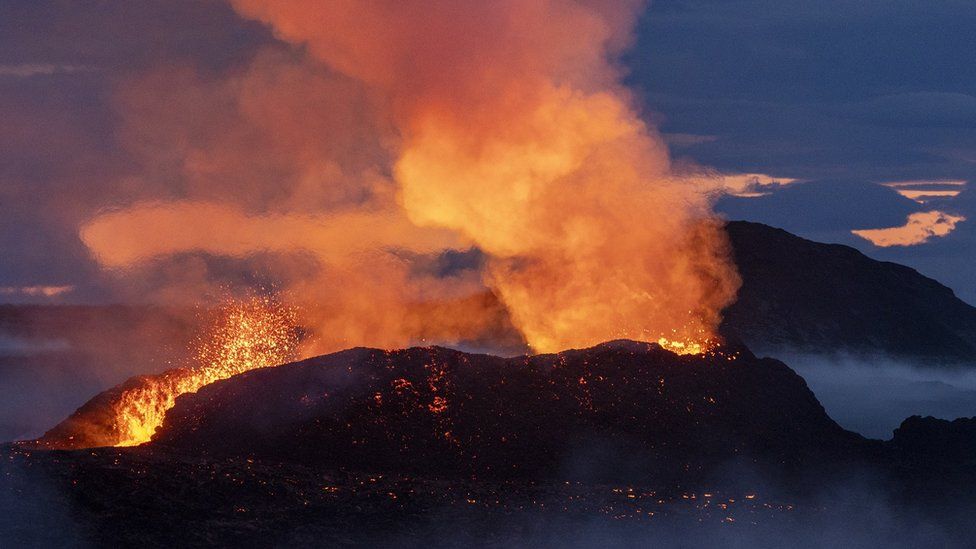ARTICLE AD BOX
 Image source, Emin Yogurtcuoglu/Getty Images
Image source, Emin Yogurtcuoglu/Getty Images
The activity is concentrated around the Fagradalsfjall volcanic area in the southwest of the country
By Esme Stallard
Climate and science reporter, BBC News
Iceland is bracing itself for a volcanic eruption in the coming days. Why is this happening, and what might be the impact?
Since late October the region surrounding the Icelandic capital, Reykavik, in the south-west has been experiencing an increase in earthquake activity.
This is due to a underground river of magma - hot liquid or semi-liquid rock - about 15-km (10 miles) in length moving upwards below the earth's surface.
This runs under Iceland and part of the Atlantic Ocean, and the impact of an eruption on the country - and further afield with regard to aviation - will depend on where exactly the magma breaches the surface.
One town, Grindavik, which lies directly above the magma, has already been evacuated, due to the risk of 'fire fountains' and noxious gasses.
Image source, Raul Moreno/SOPA Images/Getty Images
Image caption,Dr Tom Winder installs a seismograph near the Grindavik area to monitor activity
Dr Bill McGuire, professor emeritus of Geophysical & Climate Hazards, UCL, said: "Grindavik is very close to the position of the new fracture, and its survival is far from assured. Everything depends upon where magma eventually reaches the surface, but the situation doesn't look good for the residents of the town."
If a volcano erupts offshore, or erupts on land and then flows into the sea, then there is the risk of an explosive ash cloud as the super hot rock comes into contact with the water.
In April 2010, the Eyjafjallajokull volcanic eruption, caused the largest closure of European airspace since World War II, as a result of an extensive ash cloud, with losses estimated at between 1.5bn and 2.5bn euros (£1.3-2.2bn).
The circumstances of this volcanic activity are very different and therefore such an extensive impact is not expected.
"The Eyjafjallajokull eruption of 2010 was quite different as it was associated with a shield volcano topped by a glacier. It was the interaction of the magma with ice and melt water that made that eruption so explosive and dangerous for aviation. This is not the case for Fagradalsfjall", said Dr Michele Paulatto, volcanologist at Imperial College London.
The Icelandic meteorological office estimates that currently the magma is 800m from breaking ground, and as a result the likelihood of an eruption of Fagradalsfjall volcano is "high" and could happen in the coming days.
Last night the earthquakes were weaker but ground deformation continued, with rifts and cracks of a metre in depth reported in roads suggesting that the magma could be even closer to the surface - a sign that things may be coming to a head.
"In the last few years we have had a diminishing and pause in earthquakes before volcanic eruptions happen," Dr Evgenia Ilyinskaya, Icelandic geophysicist and co-director of the International Volcanic Health Hazard Network, told the BBC.
Iceland is very used to volcanic activity - successfully building a tourist industry on it - because it sits over the Mid-Atlantic Ridge. The Earth's crust is fractured into different plates, and at the ridge the Eurasian and North American plates are moving apart at a few centimetres a year. This allows magma to rise up to the surface, which erupts as lava and/or ash.
The nature of volcanic eruptions varies depending upon the rock type and how the plates are moving.
One of the most extensive eruptions in Iceland was back in 1783 when there was a flood of lava which lasted for eight months, and produced extensive sulphur clouds which hung over Northern Europe for more than five months and is estimated to have caused cooling of about 1.3C for the following two years.
Dr Ilyinskaya, who is in regular contact with geologists on the ground, told the BBC that: "It looked concerning back on Friday and Saturday that we could have something of that scale, in those rare but large events of course that would have huge implications for air quality in the Northern hemisphere.
"That is not the situation that is likely at the moment."
The latest evidence that emerged on Sunday and Monday she said suggests the eruption will be much smaller than previously thought.
Related Internet Links
The BBC is not responsible for the content of external sites.

 1 year ago
51
1 year ago
51








 English (US) ·
English (US) ·